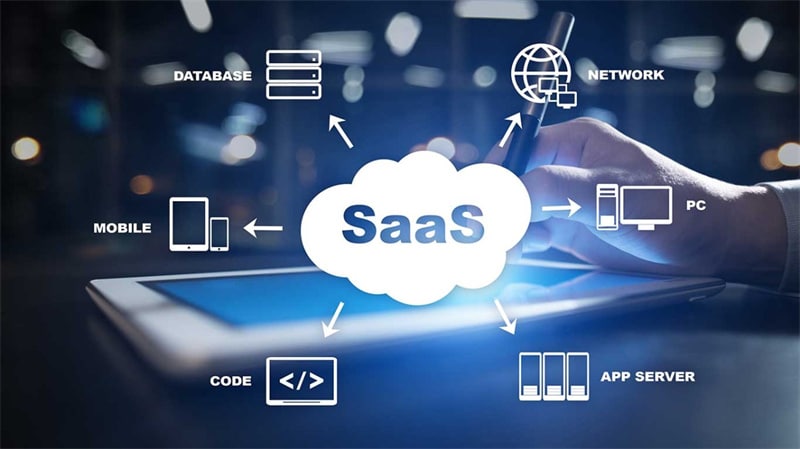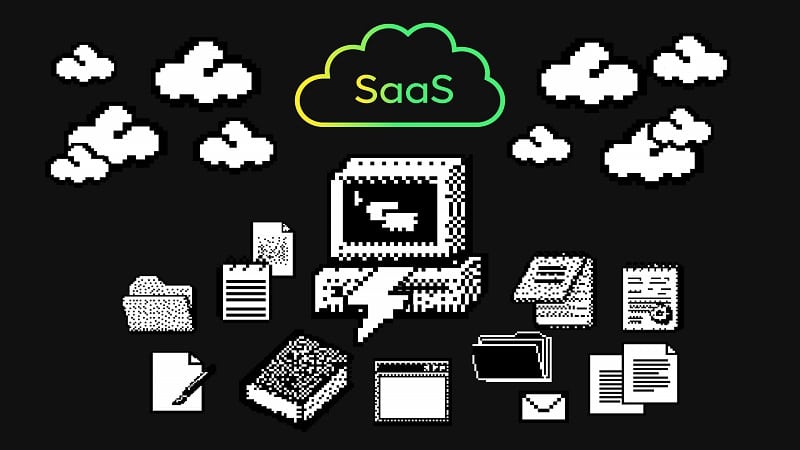Explore key SaaS model benefits and challenges in our concise guide. Maximize gains, navigate hurdles.
Software as a Service (SaaS) has revolutionized the way businesses operate, offering an array of compelling advantages that align with the agile and versatile demands of modern enterprises. Yet, alongside its numerous benefits, the SaaS model also presents a set of unique challenges that businesses must navigate to fully harness its potential.
In this detailed exploration, we will dissect the main SaaS benefits and challenges, providing a comprehensive understanding of what it takes to leverage this dynamic cloud-based service model.
SaaS Benefits

SaaS offers numerous advantages over traditional software models, contributing to its widespread popularity. These benefits include cost savings, scalability, accessibility, and much more.
Cost-Effectiveness
One significant benefit of SaaS is cost-effectiveness. Traditional software development requires substantial upfront investment in infrastructure, licenses, and maintenance. In contrast, the SaaS model benefits from economies of scale that cloud providers offer, translating into lower costs for consumers. Subscription-based pricing models inherent in SaaS solutions allow businesses to pay for software as a service benefits over time, which can be especially advantageous for small to medium-sized enterprises (SMEs) with tighter budgets.
Scalability and Accessibility
SaaS applications excel in scalability, allowing businesses to seamlessly increase or decrease their usage based on current needs, a fundamental software as a service benefit. This flexibility extends to accessibility as well; SaaS platforms are typically accessible from any device with an internet connection and web browser, providing a level of convenience and mobility that traditional software cannot match.
Continuous Updates and Upgrades
Another SaaS benefit is the model's approach to updates and upgrades. SaaS providers manage infrastructure and software updates, ensuring that all users have access to the latest features without additional costs or effort from the customer. This continuous improvement cycle is integral to the SaaS model benefits, as it keeps software current and secure without the need for user intervention.
Focus on Core Business Functions
For many companies, the ability to focus on core business functions instead of IT infrastructure is a significant benefit of SaaS. By offloading the technical aspects of software management to the provider, companies can concentrate resources on strategic business areas, rather than diverting attention to app development and maintenance.
Quick Deployment and Ease of Use
SaaS solutions are generally user-friendly and designed for quick deployment. This swift implementation allows businesses to benefit from the application almost immediately, which is a stark contrast to the lengthy and complex installation process often associated with traditional software.
Integration and Customization
Integration and customization are also SaaS model benefits. Many SaaS platforms offer APIs and integrations with other services and systems, making it easier for businesses to connect disparate systems and streamline operations. Customization options allow organizations to tailor the SaaS solutions to their specific needs, improving overall efficiency and user experience.
Expert Support and Services
One of the understated software as a service benefits is access to expert support and services from the SaaS provider. Unlike traditional software that may require a dedicated support contract, SaaS usually includes technical support as part of the subscription fee. This means businesses can rely on a SaaS development company or a SaaS application development company to provide professional assistance, which is particularly beneficial for firms without extensive in-house IT support.
Enhanced Collaboration
The collaborative power of SaaS applications is a significant benefit for organizations. Since data is stored in the cloud, it's easier for teams to work together in real-time, regardless of their physical location. This enhances productivity and ensures that team members are always working with the most up-to-date information. The ease of sharing and collaborating on documents and projects directly within the SaaS platform can greatly improve operational efficiencies.
Simplified Disaster Recovery
Another advantage of using SaaS is simplified disaster recovery. Because the data is stored in the cloud, it is typically replicated across multiple locations by the cloud provider. This redundancy means that if one data center fails, the system can switch to a backup with minimal downtime, ensuring business continuity and the integrity of critical data.
No Hardware Dependency
Eliminating the need for hardware is a considerable benefit of SaaS. Since the infrastructure is off-premises, businesses don't have to invest in or maintain costly hardware. This not only reduces capital expenditure but also lowers the ongoing cost of hardware maintenance and upgrades.
Global Reach
Developing SaaS allows businesses to scale globally with ease. SaaS solutions are available over the internet, providing businesses with the opportunity to reach customers across different regions without the need for a physical presence or the challenges of deploying software across multiple jurisdictions.
Market Responsiveness
Businesses using SaaS can respond to market changes more swiftly. Since SaaS providers continuously update their offerings, companies can benefit from the latest functionalities that address evolving market trends. This agility ensures that businesses can stay ahead of competitors by adopting new features that meet changing customer demands.
Tailored Solutions for Various Industries
A distinct SaaS model benefit is the availability of industry-specific solutions. SaaS providers cater to niche markets by offering tailored applications that meet the unique challenges of different sectors. This specificity enables organizations to use software that speaks directly to their operational needs without the one-size-fits-all limitations of traditional software packages.
Risk Mitigation
Finally, there's the benefit of risk mitigation. By outsourcing the responsibility of maintaining and securing applications to a SaaS development company or provider, a business can spread its risk. These companies usually have more robust security measures and backup processes than an individual business could feasibly implement, helping to protect against data breaches and system failures.
If you are inspired by all the SaaS benefits that we have listed, you probably look for a reliable SaaS development partner. At Clockwise Software, you will find a detailed guide on how to build your own SaaS product.
SaaS Challenges

While there are numerous SaaS benefits, there are also significant challenges that companies face when adopting this model. These can range from data security concerns to issues with application performance.
Security Concerns
Despite the many SaaS benefits, security concerns remain a significant challenge. With data hosted off-premises by a cloud provider, companies must rely on the provider's ability to secure sensitive information. While SaaS providers generally follow strict security protocols, the mere fact of handing over control can be daunting for businesses.
Downtime and Dependency
SaaS solutions are dependent on the reliability of internet connections and the cloud provider's uptime. Downtime, whether due to technical glitches or scheduled maintenance, can disrupt access to critical tools and data, posing a significant SaaS challenge for businesses heavily reliant on cloud services.
Limited Customization and Integration Complexities
While SaaS applications offer customization, they may not cater to every specific business requirement. SaaS solutions may pose integration complexities with existing on-premises systems or other cloud-based applications, which can lead to additional costs and complexity in SaaS application development services.
Data Mobility and Vendor Lock-in
Data mobility can be a hurdle when subscribing to a SaaS model. Transferring data to a different system or provider can be challenging, leading to potential vendor lock-in. This dependency can become a strategic weakness, particularly if the business needs to shift to a new platform due to changing needs or if the provider alters their pricing or service structure.
Compliance and Legal Issues
Compliance with industry regulations and legal issues is another SaaS development challenge. SaaS providers must stay current with regulations, such as GDPR or HIPAA, which can be a complex, ongoing process. Businesses must ensure their chosen SaaS solution complies with relevant laws, a responsibility that ultimately lies with them, not the SaaS provider.
Performance and Latency
Performance issues and latency are notable SaaS challenges, especially when the cloud services are hosted in distant data centers. The speed and responsiveness of SaaS applications can be subject to network latency, which can affect user experience and productivity.
Management and Monitoring
Lastly, management and monitoring of SaaS applications require attention. While providers handle much of the maintenance, businesses must still oversee user access, data security, and performance issues, which requires time and resources.
Conclusion
The adoption of SaaS brings about transformative SaaS benefits that align with the need for agile, efficient, and scalable business operations. From cost savings to scalability and ongoing support, SaaS model benefits can be a game-changer, especially for organizations looking to stay competitive in a fast-paced market.
However, it is crucial to approach SaaS solutions with a clear understanding of the potential SaaS challenges. Security, compliance, performance, and the degree of control over the service can pose significant hurdles. By addressing these challenges head-on, with the help of an experienced SaaS development company or by investing in internal SaaS development expertise, businesses can effectively mitigate risks and maximize the value of their SaaS investments.
Ultimately, whether developing SaaS applications or selecting a pre-built SaaS platform, the focus should be on creating a balanced approach that leverages the strengths of SaaS while managing its challenges. With the right strategy, the journey of building SaaS products or choosing a cloud-based SaaS application can lead to substantial business growth and success.
